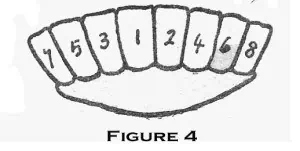Age of Sheep
Similar to gauging the age of horses, telling the age of sheep by looking at their teeth allow you to make informed decisions when buying and selling stock. For instance, sheep with a ‘broken mouth’ will deteriorate very quickly and die shortly after that, mainly when feed is short or conditions harsh. Beware of sheep with broken mouths!
Year 1
In the first year, two permanent teeth appear – 1 and 2. In Figure 1, you can see the prominent (all pictures are of the bottom jaw) and more prominent two middle teeth. This is the first year of a sheep’s life and is commonly referred to as a ‘two-tooth’.
Year 2
Figure 2 shows the teeth of a sheep at two years of age or four-tooth. In this second year, two more teeth, 3 and 4, force out A and B (Figure 1).
Year 3
Figure 3 shows a sheep with six teeth now three years old. Stages 5 and 6 appear, displacing C and D (Figure 2). Figure 4 shows a ‘full-mouthed’ sheep at four years of age (eight-tooth, although no one calls them this). You will notice that 7 and 8 have come through, and E and F have dropped out.
Years 5+
The process of estimating a sheep’s age can be difficult when it has a full mouth. This is because the animal’s physiology changes subtly over time. It is important for sheep owners and stock handlers to understand the deterioration of an animal’s teeth in order to accurately assess its age. As sheep get older, their teeth become shorter and thinner, often becoming loose in the gums. Eventually, sheep will lose their teeth, and this is when they are referred to as ‘broken mouthed’. This can lead to serious problems with sheep being able to eat efficiently. So it is important for stock handlers to be aware of these changes. With a better understanding of sheep age, farmers will be in a better position to ensure sheep are healthy.
You can also view the page How to Build a Wool Table.





